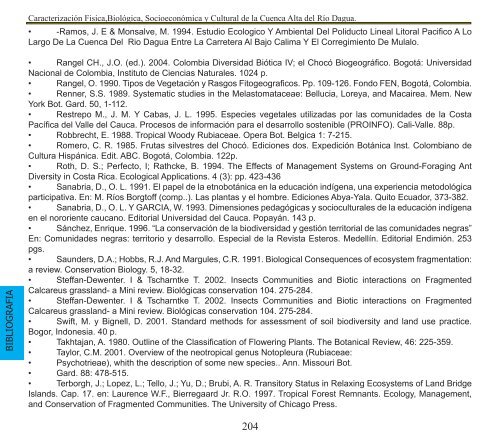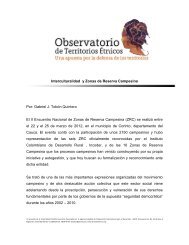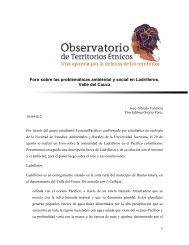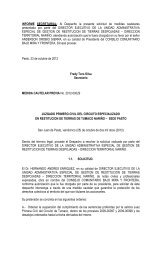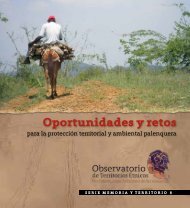Componente Biòtico
Componente Biòtico
Componente Biòtico
You also want an ePaper? Increase the reach of your titles
YUMPU automatically turns print PDFs into web optimized ePapers that Google loves.
BIBLIOGRAFIA<br />
Caracterización Fisica,Biológica, Socioeconómica y Cultural de la Cuenca Alta del Río Dagua.<br />
• -Ramos, J. E & Monsalve, M. 1994. Estudio Ecologico Y Ambiental Del Poliducto Lineal Litoral Pacifico A Lo<br />
Largo De La Cuenca Del Rio Dagua Entre La Carretera Al Bajo Calima Y El Corregimiento De Mulalo.<br />
• Rangel CH., J.O. (ed.). 2004. Colombia Diversidad Biótica IV; el Chocó Biogeográfico. Bogotá: Universidad<br />
Nacional de Colombia, Instituto de Ciencias Naturales. 1024 p.<br />
• Rangel, O. 1990. Tipos de Vegetación y Rasgos Fitogeograficos. Pp. 109-126. Fondo FEN, Bogotá, Colombia.<br />
• Renner, S.S. 1989. Systematic studies in the Melastomataceae: Bellucia, Loreya, and Macairea. Mem. New<br />
York Bot. Gard. 50, 1-112.<br />
• Restrepo M., J. M. Y Cabas, J. L. 1995. Especies vegetales utilizadas por las comunidades de la Costa<br />
Pacífica del Valle del Cauca. Procesos de información para el desarrollo sostenible (PROINFO). Cali-Valle. 88p.<br />
• Robbrecht, E. 1988. Tropical Woody Rubiaceae. Opera Bot. Belgica 1: 7-215.<br />
• Romero, C. R. 1985. Frutas silvestres del Chocó. Ediciones dos. Expedición Botánica Inst. Colombiano de<br />
Cultura Hispánica. Edit. ABC. Bogotá, Colombia. 122p.<br />
• Roth, D. S.; Perfecto, I; Rathcke, B. 1994. The Effects of Management Systems on Ground-Foraging Ant<br />
Diversity in Costa Rica. Ecological Applications. 4 (3): pp. 423-436<br />
• Sanabria, D., O. L. 1991. El papel de la etnobotánica en la educación indígena, una experiencia metodológica<br />
participativa. En: M. Ríos Borgtoff (comp..). Las plantas y el hombre. Ediciones Abya-Yala. Quito Ecuador, 373-382.<br />
• Sanabria, D., O. L. Y GARCIA, W. 1993. Dimensiones pedagógicas y socioculturales de la educación indígena<br />
en el nororiente caucano. Editorial Universidad del Cauca. Popayán. 143 p.<br />
• Sánchez, Enrique. 1996. “La conservación de la biodiversidad y gestión territorial de las comunidades negras”<br />
En: Comunidades negras: territorio y desarrollo. Especial de la Revista Esteros. Medellín. Editorial Endimión. 253<br />
pgs.<br />
• Saunders, D.A.; Hobbs, R.J. And Margules, C.R. 1991. Biological Consequences of ecosystem fragmentation:<br />
a review. Conservation Biology. 5, 18-32.<br />
• Steffan-Dewenter. I & Tscharntke T. 2002. Insects Communities and Biotic interactions on Fragmented<br />
Calcareus grassland- a Mini review. Biológicas conservation 104. 275-284.<br />
• Steffan-Dewenter. I & Tscharntke T. 2002. Insects Communities and Biotic interactions on Fragmented<br />
Calcareus grassland- a Mini review. Biológicas conservation 104. 275-284.<br />
• Swift, M. y Bignell, D. 2001. Standard methods for assessment of soil biodiversity and land use practice.<br />
Bogor, Indonesia. 40 p.<br />
• Takhtajan, A. 1980. Outline of the Classification of Flowering Plants. The Botanical Review, 46: 225-359.<br />
• Taylor, C.M. 2001. Overview of the neotropical genus Notopleura (Rubiaceae:<br />
• Psychotrieae), whith the description of some new species.. Ann. Missouri Bot.<br />
• Gard. 88: 478-515.<br />
• Terborgh, J.; Lopez, L.; Tello, J.; Yu, D.; Brubi, A. R. Transitory Status in Relaxing Ecosystems of Land Bridge<br />
Islands. Cap. 17. en: Laurence W.F., Bierregaard Jr. R.O. 1997. Tropical Forest Remnants. Ecology, Management,<br />
and Conservation of Fragmented Communities. The University of Chicago Press.<br />
204


